The remote light switch is a high-tech device that closes a circuit using a radio signal. The design includes a remote control and a receiver, which is installed near the lighting fixtures. The radio-controlled switch has many advantages; it can be installed without damaging the decorative finish of the room.
The scope of the device
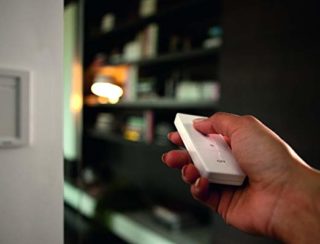
The device is designed for the convenience of residents, especially useful for the elderly and people with disabilities. If the room is large, you don't have to go to a traditional switch - just put the remote control next to it and adjust the lighting.
With the help of a radio-controlled switch, you can make any manipulations - turn on and off the light anywhere in the house, change the brightness of the devices. Street lighting can also be connected to the remote control.
The device is used in the following cases:
- You need to move the old switch, but interior items interfere with its new location. It is possible to install the switch on furniture or in any convenient place.
- Errors in the installation of electrical wiring in the house. There is no need to redo repairs and troubleshoot.
- The area of the room is small and there is no way to allocate a separate place for switches.
- Renovation has just been done, but the location of the switches is not suitable for the residents. Overhead devices are installed in a few minutes, without having to think about where the cable goes and how to hide it.
- It is necessary to organize lighting control from several points of the house, for example, from the second and third floors, from the hallway and bedroom. There is no need to run a cable to every point - it can be done remotely.
- The premises are very large, for example, a non-residential complex. Turning off and on the lights on each floor and in the rooms faster using the remote control. This will save energy, since the range of the remote control is up to 350 meters.
The devices are available in various designs, so they can be matched to any style.
Remote switches are often installed in wooden houses where fire safety rules must be followed. In order not to openly mount the wiring, you can secure the main cables going to electrical appliances, and make the shutdown remote.
Design and principle of operation
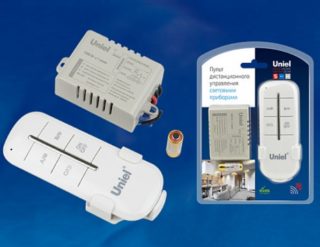
The main part of the 220V radio light switch is a relay that is activated by the remote control. On signal, the relay opens or closes the circuit. The relays are mounted near a light source - lamps, chandeliers - or inside its body. For point systems, a special junction box is equipped, inside which a signal receiver can be installed.
A switch is a transmitter that activates a relay. It operates from a voltage generator (more expensive models) or from a finger-type battery. The transmitter converts the electrical impulse into a radio signal. The device is attached anywhere. No wires are connected to it, so it can be made portable - not tied to any place. The transmitter can be used without a remote control.
The remote control transmits a signal using infrared radiation, so you can turn on the light only from the room where the switch and the receiver are located. The radio signal is more versatile - lighting can be controlled from different points in the room.
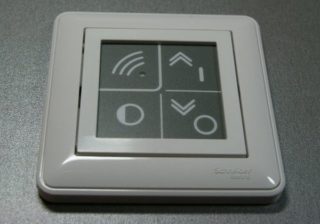
Switches are:
- Sensory. To turn on the lamp, just touch the control panel.
- Push-button. You need to press a button. There can be one or several of them.
- With a remote control. It is also possible to connect to a phone or computer if you have a router.
Some transmitters have a special device - a dimmer, which is able to adjust the degree of illumination.
In addition to the remote switch, automatic sensors can be found on sale. The principle of operation of these devices is different. The sensors can be triggered by hand claps, activated when there is movement in the room, turned on when there is little light around - they are suitable for illuminating the yard and the surrounding area. Automatic sensors are several times cheaper than remote switches.
In addition to the remote control, the lighting can be controlled using a key fob, set up according to a special program on days of the week, for example, from 5 pm in winter to 10 pm, then from 6 to 8 am. Then the programs turn off all the lights in the house. On weekends, the setting is done according to a different schedule.
All radio switches can be connected to the Smart Home system. In this case, they are connected to the system control board. The installation of the power unit - the receiver - can be carried out hidden - into the wall during repairs or over the ceilings.
Circuit breaker design
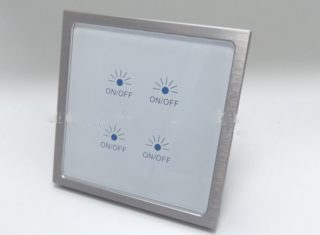
If you disassemble the switch with a screwdriver, you can find inside:
- electronic board;
- control button in the center;
- a place for a battery;
- LED lamp, which signals the binding of the unit to a specific device.
The radio module has a 10A fuse, although in practice it can withstand only 5A, that is, 1 kW.
Control and range
In terms of the range of action, all models of the relay and the switch are different, since they are designed for a certain size of the room - from 30 to 350 m. The cost of the switch with the remote control will differ in each case.
Usually the console has two control channels, but there are devices with 3 or more channels. The maximum number is 8.
With one remote control, you can turn on one light source or a whole group of electrical devices.
GSM switches work in two ways: by SMS or by call.
Advantages, disadvantages

The advantages of such systems include:
- Simple, quick installation. This can be done by a person who is absolutely not familiar with electrical engineering. Installation does not require damaging the walls for cable routing.
- Safety, especially if there are small children in the house. The current generated by the generator is so small that it will not harm a child if he disassembles the device.
- The ability to connect several devices to the power unit at once.
- It is possible to select a device for the range depending on the size of the room.
The biggest drawback is the cost of the system. Considering how many lamps, chandeliers and spotlights are in the apartment, remote light control may become unavailable for financial reasons.
Breaker control can be problematic due to a finger-type battery that is suddenly discharged. These systems are cheaper but require periodic battery replacement. Circuit breakers with their own current generator are usually more expensive, but they have a long and stable service life.
If the radio light switch is connected to the computer, but the signal of the router is weak, there may be problems with turning on the devices, so it is worth considering an alternative control method, for example, conventional switches.
Connection diagram
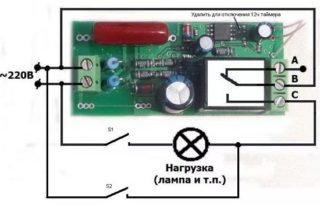
For installation, you can choose a device operating at a frequency of 315 or 433 MHz. Most people buy 433 frequencies. You can mount it on tape or self-tapping screws. In the second case, the installation is carried out in a socket box already built into the wall.
The power module is supplied with a voltage of 220 V, it itself is installed in a chandelier cap, behind the ceiling or in a junction box.
The circuit may include a contactor for street lighting, since the power of outdoor luminaires is higher.
Two more buttons can be soldered to the one-key switch, and it will become a three-key switch, then it is possible to install 2 more power blocks.
Input and output are determined by the number of terminals:
- 2 - input, voltage wires are connected here;
- 3 - output, the contacts going to the lighting device are connected here.
Next, you need to bind to a specific luminaire.
In the event of a power outage, if the device was turned on, it will not turn on by itself; if it was turned off, it will not turn on.
When choosing a device, you need to clarify how the system behaves when rebooting after a power outage. This is important, since in the absence of the owners, switching on can occur, and the meter will wind up a lot of kilowatts.
Remote control system for light in the apartment
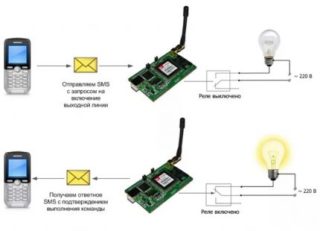
The light in the apartment can be controlled by switches, the range of which is up to 100 m or less, depending on the area of the room. If there are supporting walls in the signal path or iron reinforcement in the walls, there are radio signal repeaters that allow you to bypass obstacles and increase the power of the transmitting device.
The apartment can be equipped with 2 light control systems:
- Local, if one light source is connected to one switch.
- Global. In this case, all lamps and spot groups will be connected to a single control panel. The circuit may include air conditioners, ventilation systems, and other electrical devices such as automatic blinds or roller shutters.
In large apartments it is possible to combine the operation of sensors and a remote switch. This is necessary for temporary lighting of passage areas. The sensor is installed in the direction of travel and is triggered if a person enters a certain area, then turns off.
The device can operate in several modes:
- Temporary. When you press the button, the light turns on for a certain time, then goes out on its own.
- On / Off. When the button is pressed once, the devices are turned on or off.
- In monostable mode, when you hold down the button, the light will be on. If you let go, it will go out.
- Bistable mode is a cyclical change in the operating state of the device.
The more modes, the more expensive the equipment.
What the market offers
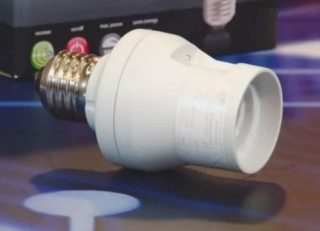
On sale you can find budget models, the range of which does not exceed 30 m, as well as advanced devices with various additional features:
- turn-on delay;
- a large number of channels;
- touch control;
- the ability to connect to a smartphone or tablet.
With an internal voltage generator, you don't have to regularly buy replacement batteries. However, if there is no alternative way of switching on, you can be left without light for the whole evening.
You can choose devices according to the manufacturer's brand, which will cost more, especially when buying imported products. The plus is that there are many design solutions.
Soldering quality can also be questionable when buying cheap Chinese products. Unfortunately, this can only be determined with a tenfold increase in the soldering point.Otherwise, you will have to focus on the number of system failures.
The cost of the product is from 400 to 5000 rubles. In the first case, these will be switches made in China, in the second - of European quality.
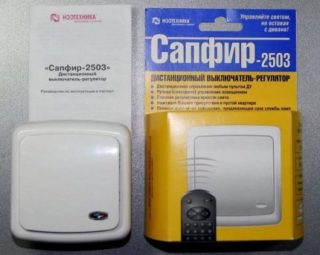
What you need to pay attention to when buying:
- The type of lighting fixtures and lamps used in them.
- The number of channels required to connect all electrical appliances. The control panel must be designed for a certain number of channels.
- Working voltage.
- Maximum load on the fuse. The device works without a transformer, so it can burn out if the voltage is exceeded.
- The radius of action is determined by the size of the room and surrounding areas, if it is a private house.
- Working voltage.
- Dimensions of the power unit and circuit breaker.
- Rated current.
- The complete set of the device. It usually does not include a battery.
The following brands of wireless switches can be found in electronics supermarkets: Feron, Zamel, Inted, BAS, Smartbuy, Z-Wave, as well as their various modifications.
How to connect a wireless remote switch with your own hands
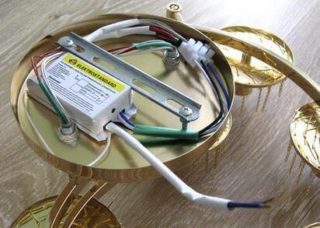
The first step is to turn off the voltage on the wires to which you plan to connect the power unit. Then the module is mounted to the wires, observing the incoming and outgoing direction of the current.
For the switch to work, you need to bind to the power unit. To do this, hold down the button and hold it until the LED indicator starts flashing quickly. In this case, you need to press a key on the switch. There should be a click of the relay when the receiver binds correctly. It will be triggered to turn on one of the lighting fixtures. To connect a second lamp to the circuit, the procedure is repeated again.
The same light can be programmed to different switches to be activated from different points of the house or apartment. The binding can be repeated for a key fob or other portable signal transmission devices, for example, a lighting control panel.
To untie the receiver from the switch, hold down the center button again for 5 seconds or more until it starts blinking slowly, then release the button on the switch.








